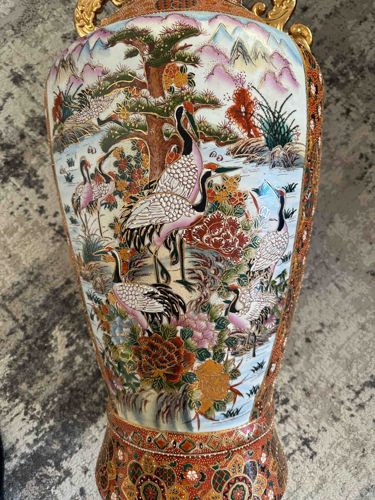
Japanese Satsuma-style Gilt-Handled Immortals and Cranes Vase
This appears to be a large, elaborately decorated vase, likely ceramic or porcelain, exhibiting characteristics of Japanese Satsuma ware, although it might also be a later interpretation or a similar Japanese style. Its overall form is bulbous at the body, tapering towards a narrower neck, and flaring out slightly at the rim, which is not fully visible. The vase is adorned with intricate hand-painted scenes featuring a congregation of cranes (a symbol of longevity and good fortune in Japanese culture) amidst a landscape of established trees (possibly pine or cypress), various flowering plants and shrubs, and mountainous terrain in the background. The color palette is rich and vibrant, incorporating reds, pinks, blues, greens, yellows, and browns, often accented with extensive gilding. Many of the details, such as the feathers of the cranes and the textures of the foliage, are rendered with a raised, tactile effect, typical of 'moriage' or raised enameled decoration. The background of the scenic panels is primarily a pale blue and white, suggesting sky and water. The upper shoulder and base of the vase, as well as the 'borders' separating the main scenes, are decorated with highly detailed geometric patterns, brocade-like motifs, and floral designs, predominantly in rich reds, coppery oranges, and browns, heavily embellished with gold accents and dots, indicative of superior craftsmanship. The vase is fitted with ornate, possibly gilded bronze or brass, handles that appear to be cast in a scrolling, decorative form, attaching to the neck/shoulder area. Visible condition suggests well-preserved paint and gilding, with no immediate indications of major cracks, chips, or repairs, though a full inspection would be required to confirm. The meticulous detail, particularly the fine line work, intricate patterns, and extensive use of gold, points to a high level of artistry and skill. Given the complex decoration and style, it likely dates from the late 19th to early 20th century.
AI-Generated Appraisal Disclaimer
Estimated Value
$1,800-2,500
Basic Information
Category
Decorative Arts - Ceramics
Appraised On
December 19, 2025
Estimated Value
$1,800-2,500
Item Description
This appears to be a large, elaborately decorated vase, likely ceramic or porcelain, exhibiting characteristics of Japanese Satsuma ware, although it might also be a later interpretation or a similar Japanese style. Its overall form is bulbous at the body, tapering towards a narrower neck, and flaring out slightly at the rim, which is not fully visible. The vase is adorned with intricate hand-painted scenes featuring a congregation of cranes (a symbol of longevity and good fortune in Japanese culture) amidst a landscape of established trees (possibly pine or cypress), various flowering plants and shrubs, and mountainous terrain in the background. The color palette is rich and vibrant, incorporating reds, pinks, blues, greens, yellows, and browns, often accented with extensive gilding. Many of the details, such as the feathers of the cranes and the textures of the foliage, are rendered with a raised, tactile effect, typical of 'moriage' or raised enameled decoration. The background of the scenic panels is primarily a pale blue and white, suggesting sky and water. The upper shoulder and base of the vase, as well as the 'borders' separating the main scenes, are decorated with highly detailed geometric patterns, brocade-like motifs, and floral designs, predominantly in rich reds, coppery oranges, and browns, heavily embellished with gold accents and dots, indicative of superior craftsmanship. The vase is fitted with ornate, possibly gilded bronze or brass, handles that appear to be cast in a scrolling, decorative form, attaching to the neck/shoulder area. Visible condition suggests well-preserved paint and gilding, with no immediate indications of major cracks, chips, or repairs, though a full inspection would be required to confirm. The meticulous detail, particularly the fine line work, intricate patterns, and extensive use of gold, points to a high level of artistry and skill. Given the complex decoration and style, it likely dates from the late 19th to early 20th century.
Related Tags
Explore similar items and categories:
Get Your Items Appraised
Instant estimates of your treasures with AI-powered instant appraisals